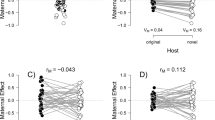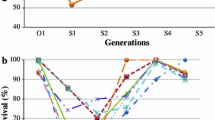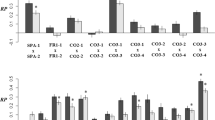Abstract
Maternal environmental effects reflect the contribution of the maternal environment to the offspring phenotype. Maternal effects are prevalent in plants and animals and may undergo adaptive evolution and affect patterns of natural selection within and across generations. Here, we raise two generations of a rapeseed (Brassica rapa) population derived from a cross between a rapid-cycling and an oilseed genotype in competitive and noncompetitive settings. Maternal environment had little effect on average offspring phenotypes. Maternal genotypes, however, differed in the sensitivity of almost all offspring phenotypes to the maternal environment, demonstrating genetic variation in maternal effects for traits expressed throughout ontogeny. Maternal environment did not significantly affect progeny seed production, and maternal genotypes were not variable for this trait, indicating no evidence for direct maternal effects on offspring fitness. Maternal environment influenced natural selection in the progeny generation; disruptive selection acted on seed mass among seeds matured in the noncompetitive maternal environment versus no significant selection on this trait for seeds matured in the competitive maternal environment. Although maternal effects did not directly increase fitness, they did affect evolutionary potential and selection in the progeny generation. These results suggest that diverse phenotypes of both wild and cultivated B. rapa genotypes will depend on the maternal environment in which the seeds are matured.


Similar content being viewed by others
References
Agrawal AA (2001) Transgenerational consequences of plant responses to herbivory: an adaptive maternal effect? Am Nat 157:555–569
Agrawal AA, Laforsch C, Tollrian R (1999) Trans-generational induction of defenses in animals and plants. Nature 401:60–63
Box GEP, Cox DR (1964) An analysis of transformations. J R Stat Soc Series B 26:211–243
Boyko A, Kovalchuk I (2011) Genome instability and epigenetic modification—heritable responses to environmental stress? Curr Opin Plant Biol 14(3):260–266
Boyko A, Blevins T, Yao YL et al (2010) Transgenerational adaptation of Arabidopsis to stress requires DNA methylation and the function of dicer-like proteins. Plos One 5(3) doi:10.1371/journal.pone.0009514
Cendan C, Sampedro L, Zas R (2013) The maternal environment determines the timing of germination in Pinus pinaster. Environ Exp Bot 94:66–72
Dechaine JM, Johnson JA, Brock MT et al (2007) Contraints on the evolution of adaptive plasticity: costs of plasticity to density are expressed in segregating progenies. New Phytol 176:874–882
Dechaine JM, Gardner G, Weinig C (2009) Phytochromes differentially regulate seed germination responses to light quality and temperature cues during seed maturation. Plant Cell Environ 32(10):1297–1309
Donohue K (1999) Seed dispersal as a maternally influenced character: mechanistic basis of maternal effects and selection on maternal characters in an annual plant. Am Nat 154(6):674–689
Donohue K (2009) Completing the cycle: maternal effects as the missing link in plant life histories. Philos Trans R Soc Lond B Biol Sci 364:1059–1074
Donohue K, Schmitt J (1998) Maternal environmental effects in plants: Adaptive plasticity? In: Mousseau TA, Fox CW (eds) Maternal effects as adaptations. Oxford University Press, New York, pp 137–158
Donohue K, Dorn LA, Griffith C et al (2005a) Environmental and genetic influences on the germination of Arabidopsis thaliana in the field. Evolution 59(4):740–757
Donohue K, Dorn LA, Griffith C et al (2005b) Niche contruction through germination cueing: life history responses to timing of germination in Arabidopsis thaliana. Evolution 59(4):758–770
Donohue K, Barua D, Butler C et al (2012) Maternal effects alter natural selection on phytochromes through seed germination. J Ecol 100(3):750–757
Espeland EK, Rice KJ (2012) Within and transgenerational plasticity affects the opportunity for selection in barbed goatgrass, (Aegilops triuncialis). Am J Bot 99(12):2058–2062
Galloway L (1995) Response to natural environmental heterogeneity: maternal effects and selection of life-history characters and plasticities in Mimulus guttatus. Evolution 49(6):1095–1107
Galloway L (2001) Parental environmental effects on life history in the herbaceous plant Campanula americana. Ecology 82:2781–2789
Galloway L (2005) Maternal effects provide phenotypic adaptation to local environmental conditions. New Phytol 166:93–100
Galloway LF, Etterson JR (2007) Transgenerational plasticity is adaptive in the wild. Science 318:1134–1136
Galloway LF, Etterson JR (2009) Plasticity to canopy shade in a monocarpic herb: within- and between-generation effects. New Phytol 182(4):1003–1012
Hangelbroek HH, Santamaria L, de Boer T (2003) Local adaptation of the pondweed Potamogeton pectinatus to contrasting substrate types mediated by changes in propagule provisioning. J Ecol 91:1081–1092
Herman JJ, Sultan SE, Horgan-Kobelski T et al (2012) Adaptive transgenerational plasticity in an annual plant: grandparental and parental drought stress enhance performance of seedlings in dry soil. Integr Comp Biol 52(1):77–88
Holeski LM, Jander G, Agrawal AA (2012) Transgenerational defense induction and epigenetic inheritance in plants. Trends Ecol Evol 27(11):618–626
Iniguez-Luy F, Lukens L, Farnham M et al (2009) Development of public immortal mapping populations, molecular markers and linkage maps for rapid cycling Brassica rapa and B. oleracea. Theor Appl Genet 120:31–43
Jacobs BS, Lesmeister SA (2012) Maternal environmental effects on fitness, fruit morphology and ballistic seed dispersal distance in an annual forb. Funct Ecol 26(3):588–597
Johnsen O, Daehlen OG, Ostreng G et al (2005) Daylength and termperature during seed production interactively affect adaptive performance of Picea abies progenies. New Phytol 168:589–596
Kawecki TJ, Ebert D (2004) Conceptual issues in local adaptation. Ecol Lett 7:1225–1241
Lacey EP (1996) Parental effects in Plantago lanceolata l. I.: a growth chamber experiment to examine pre- and postzygotic termperature effects. Evolution 50(2):865–878
Lacey EP, Herr D (2000) Parental effects in Plantago lanceolata l. Iii. Measuring parental temperature effects in the field. Evolution 54(4):1207–1217
Lande R, Arnold SJ (1983) The measurement of selection on correlated characters. Evolution 37(6):1210–1226
Latzel V, Klimesova J (2010) Year-to-year changes in expression of maternal effects in perennial plants. Basic Appl Ecol 11:702–708
Latzel V, Janecek S, Dolezal J et al (2014) Adaptive transgenerational plasticity in the perennial Plantago lanceolata. Oikos 123(1):41–46
Linhart YB, Grant MC (1996) Evolutionary significance of local genetic differentiation in plants. Annu Rev Ecol Syst 27:237–277
Miao S, Bazzaz A, Primack R (1991) Persistence of maternal nutrient effects in Plantago major: the third generation. Ecology 72:1634–1642
Mitchell-Olds T (1996) Pleiotropy causes long-term genetic contraints on life-history evolution in Brassica rapa. Evolution 50:1849–1858
Moran MD (2003) Arguments for rejecting the sequential Bonferroni in ecological studies. Oikos 100:403–405
Mousseau TA, Fox CW (1998) The adaptive significance of maternal effects. Trends Ecol Evol 13(10):403–407
Nakagawa S (2004) A farewell to Bonferroni: the problems of low statistical power and publication bias. Behav Ecol 15(6):1044–1045
Plantenkamp GAJ, Shaw RG (1993) Environmental and genetic maternal effects on seed characters in Nemophia menziesii. Evolution 47(2):540–555
Poelman JM, Sleper DA (1995) Breeding field crops. Iowa University Press, Ames
Reinhold K (2002) Maternal effects and the evolution of behavioral and morphological characters: a literature review indicates the importance of extended maternal care. J Hered 93(6):400–405
Roach DA, Wulff RD (1987) Maternal effects in plants. Annu Rev Ecol Syst 18:209–235
Schmid B, Dolt C (1994) Effects of maternal and paternal environment and genotype on offspring phenotype in Soldago altissima l. Evolution 48(5):1525–1549
Schmitt J, Niles J, Wulff RD (1992) Norms of reaction of seed traits to maternal environments in Plantago lanceolata. Am Nat 139(3):451–466
Smith H (1982) Light quality, photoperception and plant strategy. Annu Rev Plant Physiol 33:481–518
Smith H, Casal JJ, Jackson GM (1990) Reflection signals and the perception by phytochrome of the proximity of neighbouring vegetation. Plant Cell Environ 13:73–78
Stratton DA (1989) Competition prolongs expression of maternal effects in seedlins of Erigeron annuus (asteraceae). Am J Bot 76:1646–1653
Sultan SE (1996) Phenotypic plasticity for offspring traits in Polygonum persicaria. Ecology 77:1791–1807
Suter L, Widmer A (2013) Phenotypic effects of salt and heat stress over three generations in Arabidopsis thaliana. Plos One 8(11) doi:10.1371/journal.pone.0080819
Van Dam NM, Baldwin IT (2001) Competition mediates costsof jasmonate-induced defences, nitrogen aquisition and transgenerational plasticity in Nicotiana attenuata. Funct Ecol 15:406–415
Van Zandt PA, Mopper SM (2004) The effects of maternal salinity and seed environment on germination and growth of Iris hexagona. Evol Ecol Res 6:813–832
Wulff RD, Caceres A, Schmitt J (1994) Seed and seedling responses to maternal and offspring environments in Plantago lanceolata. Funct Ecol 8:763–769
Acknowledgments
We thank J. Johnston for the experimental design of the maternal generation and J. Stringer, K. Krueger, and K. Dorn for assistance in data collection and plant processing. We are also grateful to M. McClellan of the UMN Agricultural Experiment Station and P. Warnke and staff of the UMN Horticultural Greenhouses. This work was supported by NSF grant IOS-0923752 to CW.
Author information
Authors and Affiliations
Corresponding author
Rights and permissions
About this article
Cite this article
Dechaine, J.M., Brock, M.T. & Weinig, C. Maternal environmental effects of competition influence evolutionary potential in rapeseed (Brassica rapa). Evol Ecol 29, 77–91 (2015). https://doi.org/10.1007/s10682-014-9735-6
Received:
Accepted:
Published:
Issue Date:
DOI: https://doi.org/10.1007/s10682-014-9735-6




